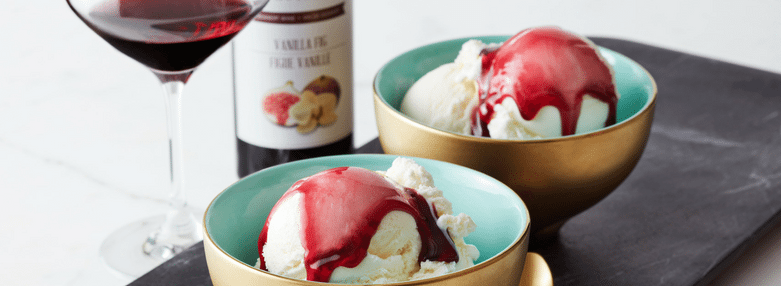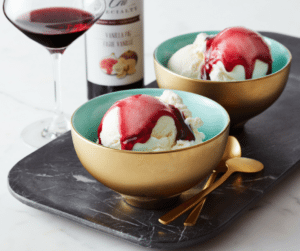Craft & Cork >> Wine

Dessert Wines 101
With all of the sweet treats, after dinner desserts, and celebrations ahead this holiday season, we wanted to provide you with some dessert wines 101 to not only help you understand wines better – but also to provide you with some tips for serving and enjoying these rich, decadent wines.
What are Dessert Wines?
In the context of wine styles, a dessert wine is defined as sweet and luscious; featuring concentrated flavours. Dessert wines can be made with grapes that have a high sugar level or brix at harvest, or from partially dehydrated grapes. Dessert wines can also be fortified wines, like Ports and Vins Doux Naturels.
Most Common Dessert Wines
- Ice Wines
- Fortified Wines
Here is a bit more information on them for your interest:
Ice Wines – Vidal, Riesling, Cabernet Franc
 Ice wines are produced from grapes that have been frozen while still on the vine. The sugars and other dissolved solids do not freeze, but the water does allowing a more concentrated grape must to be pressed from the frozen grapes, resulting in a smaller amount of more concentrated, very sweet, viscous wine. With ice wines, the freezing happens before the fermentation, not afterwards. The grapes are ready for harvest after 3 consecutive days of temperatures of -10 degrees. The grapes are then crushed right away. Germany and Canada are the biggest producers of Ice Wines. The most common grapes that are used in this wine tend to be Vidal and Riesling.
Ice wines are produced from grapes that have been frozen while still on the vine. The sugars and other dissolved solids do not freeze, but the water does allowing a more concentrated grape must to be pressed from the frozen grapes, resulting in a smaller amount of more concentrated, very sweet, viscous wine. With ice wines, the freezing happens before the fermentation, not afterwards. The grapes are ready for harvest after 3 consecutive days of temperatures of -10 degrees. The grapes are then crushed right away. Germany and Canada are the biggest producers of Ice Wines. The most common grapes that are used in this wine tend to be Vidal and Riesling.
Nobel Rot: In very rare occasions, ‘nobel rot’ or Botrytis, a type of fungus that shrivels and decays wine grapes can occur in ice winemaking. However, this is the one instance where a vineyard full of rotting grapes is a good thing! It does two things to wine: intensifies the sweetness level and adds flavour complexity.
General Flavour Profile: Dried fruits (apricot, quince), honey, spices, etc.
Service Temperature: 6-9 degrees
Food pairing: Blue cheese with dried apricot, crème brûlée, apple strudel
If you would like to craft your own ice wine our RJS Craft Winemaking Cru Specialty Vidal style, Cabernet Franc, or Riesling style are all delightful picks!
Fortified Wines – Sherry, Port and Madeira

Port is a fortified wine, meaning that the fermentation was stopped by the addition of a neutral grape based spirit. This ups the alcohol content to around 18 percent in spite of the high brix. Port can only be made with 5 grape varieties, and only in the Porto DOP in Portugal.
Different Styles: Ruby / Vintage and Tawny. The latter being aged in neutral oak barrels for a set period of time before bottling.
General Flavour Profile: Red berries, raisins, cocoa and spices.
Serving Temperature: 7-10 degrees
Pairing: Fruit cake infused with brandy, Stilton, dark chocolate truffles, etc.
Special Crafting Tip: You can also personalize you craft dessert wine further by adding Brandy before bottling!
If you like Port, we recommend trying our Cru Specialty Premium Dessert wine.
Rules of Thumb for Serving Dessert Wines
Chilled or Room Temp?
Serve whites chilled.
Serve reds at room temperature, or slightly chilled.
Pairings
 Dessert wines offer nuances and delicate flavours and eating a sweet, decadent dessert could mask them. Simple dessert pairings do best, such as Port with warm chocolate torte, or Ice Wine with homemade vanilla ice cream.
Dessert wines offer nuances and delicate flavours and eating a sweet, decadent dessert could mask them. Simple dessert pairings do best, such as Port with warm chocolate torte, or Ice Wine with homemade vanilla ice cream.
If you would like to pair other foods with your dessert wines, the general rule of thumb is to ensure that the wine is sweeter than the food. These wines are also a great match with saltier foods (think Blue Cheese!).
Alone or with Dessert?
One misconception about dessert wines is that you need dessert to go with them. While there are some amazing dessert pairings to go with these wines, the wine itself is a great dessert on its own as well.
Why not shake things up this year and serve a hand crafted, decadent dessert wine for your holiday dinner dessert?


Recent Comments